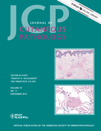PI3K, Rac1 and pPAK1 are overexpressed in extramammary Paget's disease
Abstract
Background
Phosphatidylinositol 3-kinase (PI3K), Ras-related C3 botulinum toxin substrate 1 (Rac1) and P21-activated protein kinase 1 (PAK1) appear to play important roles in the pathogenesis of several tumors, but their expressions in extramammary Paget's disease (EMPD) have not been investigated yet.
Objectives
To investigate the potential contribution of the PI3K, Rac1 and PAK1 to the development of EMPD.
Methods
Thirty-five paraffin-embedded EMPD specimens were subjected to immunohistochemical staining for PI3K (85α), Rac1 and pPAK1.
Results
All the 35 primary EMPD specimens, including 20 non-invasive EMPD, 13 invasive EMPD and 2 metastatic lymph nodes, showed cytoplasm overexpression of PI3K (85α), Rac1 and pPAK1. The expression (% positive cells) of PI3K(85α), Rac1 and pPAK1 (90.1 ± 8.6, 91.4 ± 9.5 and 89.6 ± 10.8% ) in EMPD were significantly higher than in apocrine glands of normal skin ( 20.1 ± 11.9, 29.8 ± 8.9, 41.1 ± 13.4%), and the expression in invasive EMPD with lymph node metastasis (98.2 ± 1.7, 98.8 ± 0.7 and 98.4 ± 0.9%) are significantly higher than in invasive EMPD without lymph node metastasis (94.1 ± 2.6, 96.5 ± 1.7 and 95.3 ± 1.1%) and non-invasive EMPD (85.2 ± 8.4, 87.1 ± 9.9 and 83.1 ± 10.6%). There were significant positive correlations of the expression levels between PI3K (85α) and Rac1, as well as between Rac1 and pPAK1 in EMPD.
Conclusions
These results indicate that PI3K, Rac1 and PAK1 may play important roles in the pathogenesis of EMPD.




